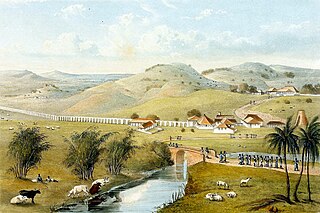
Alexander Lindsay, 6th Earl of Balcarres and de jure 23rd Earl of Crawford was the son of James Lindsay, 5th Earl of Balcarres. He was a general in the British Army.
The First Maroon War was a conflict between the Jamaican Maroons and the colonial British authorities that started around 1728 and continued until the peace treaties of 1739 and 1740. It was led by self-liberated Africans who set up communities in the mountains. The name "Maroon" was given to these Africans, and for many years they fought the British colonial Government of Jamaica for their freedom. The maroons were very skilled particularly in guerrilla warfare. It was followed about half a century later by the Second Maroon War.

The Second Maroon War of 1795–1796 was an eight-month conflict between the Maroons of Cudjoe's Town, a Maroon settlement later re-named after Governor Edward Trelawny at the end of First Maroon War, located near Trelawny Parish, Jamaica in the St James Parish, and the British colonials who controlled the island. The Windward communities of Jamaican Maroons remained neutral during this rebellion and their treaty with the British still remains in force. Accompong Town, however, sided with the colonial militias, and fought against Trelawny Town.

Tacky's War, Tacky's Revolt, or Tacky's Rebellion was a widespread fight for their freedom by enslaved people in the British Colony of Jamaica in the 1760s. Led by Akan people -- tribes including Ashanti, Fanti, Nzema and Akyem, -- it was loosely led by a Fanti royal and warlord called Tacky (Takyi) in eastern Jamaica, and Dahomean war chief or coastal headman Apongo in the western end of the island.
Jamaican Maroons descend from Africans who freed themselves from slavery on the Colony of Jamaica and established communities of free black people in the island's mountainous interior, primarily in the eastern parishes. Africans who were enslaved during Spanish rule over Jamaica (1493–1655) may have been the first to develop such refugee communities.
Major John Jarrett was a Jamaican Maroon leader of the Maroons of Cudjoe's Town in Jamaica. He was most likely named after a neighbouring planter with a similar surname.
The Jamaican Maroons in Sierra Leone were a group of just under 600 Jamaican Maroons from Cudjoe's Town, the largest of the five Jamaican maroon towns who were deported by the British authorities in Jamaica following the Second Maroon War in 1796, first to Nova Scotia. Four years later in 1800, they were transported to Sierra Leone.
Maroon Town is a settlement in Jamaica. It has a population of 3122 as of 2009.
Moore Town is a Maroon settlement located in the Blue Mountains and John Crow Mountains of Portland, Jamaica, accessible by road from Port Antonio. The easternmost Maroon town, Moore Town is located in the eastern end of the parish. Formerly known as New Nanny Town, Moore Town was founded in 1740 when the Peace Treaty was signed between the British colonial authorities and the Windward Maroons. This treaty allotted the Moore Town Maroons 1000 acres, but Moore Town only received 500. In 1781 the initial 500 acres was augmented with another 500 acres, taking their communal land up to 1,000 acres.
Cudjoe, Codjoe or Captain Cudjoe, sometimes spelled Cudjo – corresponding to the Akan day name Kojo, Codjoe or Kwadwo – was a Maroon leader in Jamaica during the time of Nanny of the Maroons. In Twi, Cudjoe or Kojo is the name given to a boy born on a Monday. He has been described as "the greatest of the Maroon leaders."
Major-General The Honourable George Walpole, was a British soldier and politician. He gained distinction after suppressing the Maroon insurrection in Jamaica in 1795. After entering Parliament in 1797, he served as Under-Secretary of State for Foreign Affairs from 1806 to 1807 in the Ministry of All the Talents headed by Lord Grenville.

Cudjoe's Town was located in the mountains in the southern extremities of the parish of St James, close to the border of Westmoreland, Jamaica.
Quao was one of the leaders of the Windward Maroons, who fought the British colonial forces of Jamaica to a standstill during the First Maroon War of the 1730s. The name Quao is probably a variation of Yaw, which is the Twi Akan name given to a boy born on a Thursday.
Samuel Grant (1741-1808), Maroon officer from Charles Town, Jamaica. Sam Grant was an officer of the Jamaican Maroons who made a career out of hunting runaway slaves.
Montague James was a Maroon leader of Cudjoe's Town in the last decade of eighteenth-century Jamaica. It is possible that Maroon colonel Montague James took his name from the white superintendent of Trelawny Town, John Montague James.
Cuffee was an escaped slave in Jamaica who led other runaway slaves to form a community of Free black people in Jamaica in the island's forested interior, and they raided white plantation owners at the end of the eighteenth century. The name Cuffee is a variation of the Twi Akan name Kofi, which is the name given to a boy born on a Friday.
Charles Samuels was a maroon officer from Cudjoe's Town, and he was the brother of Captain Andrew Smith. Both officers reported to Colonel Montague James, the leader of Trelawny Town.
Charles Town is one of four official towns of the Jamaican Maroons. It is located on Buff Bay River in Portland Parish.
Free black people in Jamaica fell into two categories. Some secured their freedom officially, and lived within the slave communities of the Colony of Jamaica. Others ran away from slavery, and formed independent communities in the forested mountains of the interior. This latter group included the Jamaican Maroons, and subsequent fugitives from the sugar and coffee plantations of coastal Jamaica.





